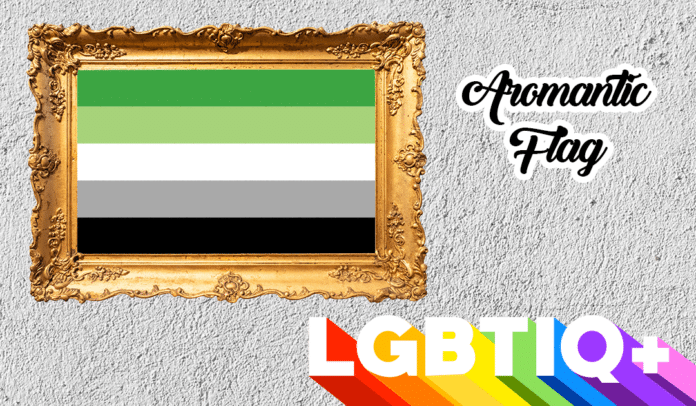As we delve into the significance of the aromantic flag, we embark on a journey to uncover the stories, struggles, and triumphs of individuals who proudly wave its colours, asserting their presence in the tapestry of human diversity.
In a world that celebrates the myriad shades of human connection and emotion, the tapestry of identities expands, revealing the intricate threads that make up the rich fabric of human experience.
Among these identities lies a profound and often misunderstood aspect of human orientation: aromanticism. While discussions surrounding romantic and s3xual orientations have gained significant traction, the aromantic flag remains relatively unexplored in the mainstream discourse.

Just as a painter employs colours to create a masterpiece, individuals on the aromantic flag have embraced a symbol that embodies their experiences and feelings—a flag that resonates with their identity.
Beyond being a mere representation of colours, the aromantic flag is a powerful emblem that encapsulates the diverse narratives of those who navigate a world that places romantic love on a pedestal.
Join us as we unravel the layers of meaning behind each hue and shade, illuminating a corner of the human experience that is as vivid and valid as any other.
SEE ALSO: Top 5 Mistakes After Knee Replacement
Aromantic Flag Meaning
The aromantic flag is a symbol that holds deep significance for individuals who identify as aromantic, a term that describes those who experience little to no romantic attraction towards others. The flag’s design consists of five horizontal stripes of different colours, each representing specific aspects of the aromantic experience.

Let’s delve into the extensive explanation of the meanings behind each colour:
1. Dark Green
The top stripe of the flag is a dark shade of green. This colour serves as a representation of the aromantic orientation itself. Just as green is often associated with growth, renewal, and nature’s vitality, the dark green stripe symbolises the diversity and vitality of the aromantic community.
It affirms the validity of aromantic identities, inviting individuals to embrace and celebrate their unique experiences.
READ ALSO: Understanding 4 Types Of Personalities
2. Light Green
The second stripe, a lighter shade of green, signifies the broader spectrum of relationships beyond traditional romantic attachments. It represents the importance of non-romantic relationships such as friendships, platonic bonds, and connections that bring joy, fulfilment, and meaning to an aromantic person’s life.
This light green stripe celebrates human connections’ richness in all forms.
3. White
Positioned at the centre, the white stripe embodies the concept of a spectrum of identities. In the context of the aromantic flag, white signifies the intersectionality of aromanticism with other aspects of an individual’s identity, such as gender, s3xuality, and culture.
This stripe emphasises inclusivity and acknowledges the diversity within the aromantic community, recognising that aromantic experiences are intertwined with many personal traits.
4. Gray
The fourth stripe, in varying shades of grey, represents the complexities of human emotions. This stripe highlights the nuanced space that exists between romantic and aromantic orientations. Gray symbolizes the emotional spectrum and the recognition that feelings are not strictly black and white.
It acknowledges that emotions can be fluid and multifaceted and exist on a continuum. This stripe invites individuals to explore their emotions without the confines of rigid categories.
5. Black
The bottom stripe of the flag is black. This colour serves a dual purpose: it acknowledges the challenges and difficulties that some aromantic individuals might face due to societal misunderstandings or discrimination.
It also represents the aromantic community’s strength, resilience, and solidarity. The black stripe underscores the importance of supporting one another, standing united, and celebrating the unique aromantic experiences that shape each individual’s journey.
The aromantic pride flag is a vibrant tapestry of colours that encapsulates the aromantic experience from various angles. It is a powerful emblem of identity, acceptance, and self-expression, visually representing the emotions, relationships, and challenges that define the aromantic community.
Displaying the aromantic pride flag signifies a commitment to fostering understanding, awareness, and appreciation for an often-overlooked facet of human diversity, inviting individuals to explore and embrace their authentic selves within the spectrum of human connections.
SEE ALSO: What Are We? 10 Ways To Address This Scary Question In A Relationship
As3xual Aromantic
Identifying as both as3xual and aromantic can bring about a unique and multifaceted experience of human orientation. As3xuality refers to an individual’s lack of s3xual attraction to others, while aromanticism pertains to a lack of romantic attraction.
When combined, these orientations form the basis for as3xuality and aromanticism, often referred to as being “ace” (for as3xual) and “aro” (for aromantic).

Individuals who identify as as3xual and aromantic navigate a world that predominantly places a high value on romantic and s3xual relationships. This can lead to a variety of experiences and feelings, ranging from empowerment and self-discovery to challenges related to societal norms and expectations.
Here’s an exploration of some key aspects of being as3xual and aromantic:
- Self-Understanding: Discovering and embracing one’s as3xual and aromantic identities can be empowering and affirming. It allows individuals to understand themselves on a deeper level, connecting with a community that shares similar experiences.
- Navigating Relationships: As3xual, aromantic individuals often prioritize non-romantic and non-s3xual relationships in their lives, such as friendships and chosen family bonds. These relationships can be just as fulfilling and meaningful as romantic or s3xual partnerships for them.
- Social Pressures: Living in a society that often prioritizes romantic and s3xual relationships can lead to feelings of alienation or misunderstanding. As3xual, aromantic individuals might face pressure to conform to societal norms, leading to a need for advocacy and education about their orientations.
- Intersectionality: As3xual, aromantic individuals have complex identities that intersect with other aspects, such as gender, culture, and ethnicity. Intersectionality adds layers to their experiences, influencing how they navigate their identities within different contexts.
- Visibility and Representation: The lack of visibility and representation of as3xuality and aromanticism in mainstream media and discussions can create feelings of isolation. However, efforts to increase awareness and representation are helping to create more inclusive spaces.
- Personal Growth and Empowerment: Embracing one’s as3xual, aromantic identity can lead to personal growth, self-acceptance, and empowerment. Connecting with others who share similar experiences can provide a sense of belonging and validation.
- Challenging Assumptions: Being as3xual and aromantic challenges common assumptions about the necessity of romantic and s3xual relationships for a fulfilled life. This challenges societal norms and prompts important conversations about diverse forms of human connection and happiness.
- Advocacy and Community: As3xual, aromantic individuals often engage in advocacy to raise awareness and promote understanding about their orientations. Online and offline communities provide spaces for connection, support, and sharing experiences.
In summary, identifying as as3xual and aromantic is an important aspect of the diverse spectrum of human orientations. It brings to light the varied ways people experience relationships, emotions, and connections.
As understanding and acceptance continue to grow, individuals who identify as as3xual aromantic are finding their voices, building supportive communities, and shaping a more inclusive narrative around love, relationships, and identity.
READ ALSO: Score a Date: The Online Toast Formula to Win Her Heart
As3xual Flag
The as3xual and aromantic pride flags are symbolic representations of the as3xual and aromantic communities, respectively. These flags serve to raise awareness, promote understanding, and provide a visual symbol for individuals who identify as as3xual and aromantic. Let’s explore the meanings behind each flag:
As3xual Pride Flag: The as3xual pride flag consists of four horizontal stripes of different colours, each carrying its own significance:
- Black Stripe: The black stripe represents as3xuality as a whole. It symbolizes as3xuality as a valid orientation and acknowledges the challenges and misconceptions that as3xual individuals may face in a society that often centres around s3xual attraction.
- Gray Stripe: The grey stripe represents grey as3xuality and demis3xuality. Grey-as3xuality refers to individuals who may experience some level of s3xual attraction but not as frequently or intensely as allos3xual (non-as3xual) individuals. Demis3xuality describes individuals who experience s3xual attraction only in the context of a close emotional bond.
- White Stripe: The white stripe symbolizes s3xuality. This stripe represents non-s3xual individuals, highlighting the spectrum of s3xual orientations and emphasizing the coexistence of as3xual and non-as3xual orientations within society.
- Purple Stripe: The purple stripe signifies community. It represents the unity, pride, and support among as3xual individuals and allies. Purple is often associated with diversity and is used to express the shared experiences of as3xual individuals around the world.
In a world that often focuses on traditional romantic and s3xual relationships, the as3xual and aromantic pride flags stand as powerful symbols of identity, diversity, and acceptance. With their vibrant colours and meaningful design, these flags encapsulate the experiences and narratives of individuals who identify as as3xual and romantic.
They carry a profound message of unity, self-discovery, and the importance of celebrating every facet of the human experience. The as3xual pride flag, with its black, grey, white, and purple stripes, represents a spectrum of as3xual identities.
It boldly proclaims the validity of as3xuality and challenges misconceptions surrounding this orientation. The flag acts as a beacon of support, reminding as3xual individuals that they are not alone and allies that they play a crucial role in advocating for understanding and acceptance.
Likewise, the aromantic pride flag, adorned with shades of green, white, grey, and black, vividly depicts the aromantic experience. It speaks to the depth of non-romantic connections, the complexity of emotions, and the strength of the aromantic community.
This flag calls for a wider recognition of the various forms of love and bonds that shape our lives, encouraging a more inclusive perspective on relationships.
READ ALSO: 10 Good Habits To Develop To Have A Meaningful And Successful Life
FAQs for Aromantic Flag
How many people are aromantic?
“As3xual and Aromantic people make up about 1% of the total population but comprise as high as 4% of those ages 18-24 (Bianchi, 2018). This group is very small but growing as knowledge of the identity spreads.
can aromantic fall in love?
Aromantic people can experience love. Being aromantic doesn’t mean that you don’t feel or experience love. You may experience strong feelings of love for family and friends.
Can Aromantic still have crushes?
Yes—aromantics can experience different kinds of attraction. Occasionally, an aromantic might feel s3xual attraction or even have a platonic crush on someone.
How am I aromantic?
You feel platonic love for others but not romantic love. Staying connected with others may be important to an aromantic individual; however, these connections may primarily consist of friends and family. You feel s3xual attraction to others but not romantic attraction.
what is Greyromantic?
Greyromantic is a term that is used to describe people who feel a limited or uncertain romantic attraction to others.
What is a Cupioromatic Flag?
Cupioromantic (kalosromantic) describes the orientation of people who do not experience romantic attraction but still do not want a romantic relationship of some sort.
can you be aromantic but not as3xual?
Not all as3xual people are aromantic, and not all aromantic people are as3xual — but some people are both.





